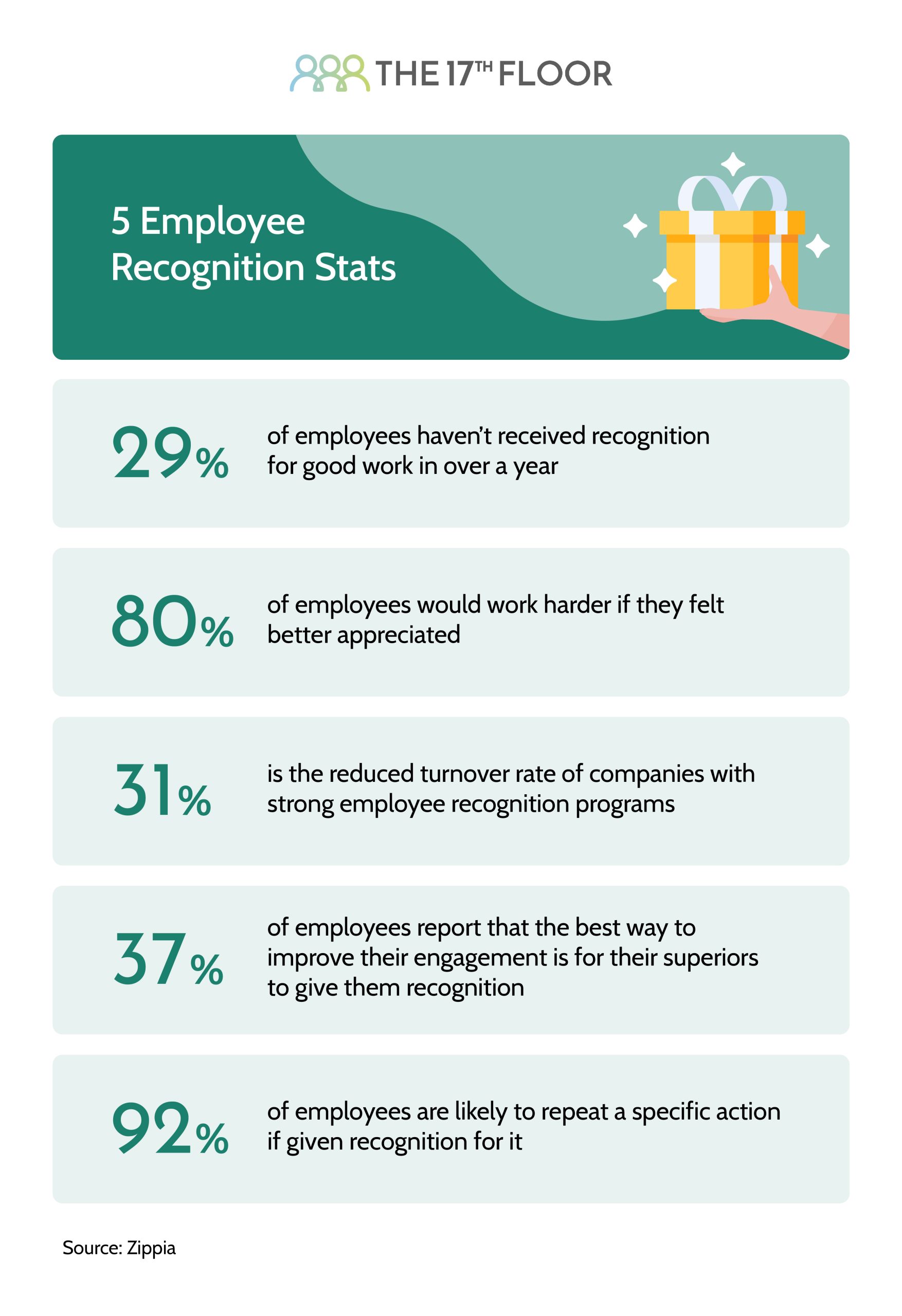5 Tips for Employee Recognition and Fostering a Culture of Appreciation

It is safe to say that the last couple of years have been challenging for everyone, so when it comes to the workplace, nurturing a culture of appreciation isn’t just good practice; it’simperative.
The modern workplace thrives when employees feel valued and recognized for their contributions. In fact, employees who are recognized are almost six times more likely to stay at their jobs than those who aren’t, according to Zippia.
If you think this statistic is astonishing, check check out this infographic to discover how important recognizing and rewarding your employees for their good work is!

Employees who are recognized are almost 6x more likely to stay at their jobs than those who aren’t.
Practical Checklist for Recognizing and Rewarding Employees
1. Personalized Recognition Programs
Not all employees are the same or feel appreciated in the same way. Managers should implement personalized recognition programs that cater to individual preferences and achievements.
Gathering information about how your employees want to be recognized can be a challenge. Learn about your employees by asking them to fill out a Staff Favorites Questionnaire. Ask employees about their favourite foods, activities, and treats. Employees can select types of apparel and drinkware they’re most likely to use if received as a gift.
2. Timely Acknowledgment
Recognizing and rewarding employees promptly is essential, as delayed recognition loses its impact. Take this advice from employee recognition experts: Great Place to Work!
The longer it takes for managers to recognize employees, the less likely employees will see the affirmations as authentic. Make employee recognition a priority and have formal recognition systems in place so you can strike while the iron is hot.
3. Peer-to-Peer Recognition
Employee recognition goes beyond supervisors showing appreciation for their employees’ work. Peer-to-peer recognition is also important, and managers should also be encouraging it. Quantum Workplace affirms that “41% of workers want more recognition from their immediate coworkers.”
It can also foster a positive team culture and encourage collaboration and teamwork. Companies that prioritize peer-to-peer recognition as part of their recognition program are likely to see a significant impact on employee engagement, productivity, and retention rates.
4. Tangible Rewards
Even though intangible rewards like experiences such as wine tastings or massages are very popular nowadays, many employees appreciate tangible rewards. This means rewards in addition to the basic salary. They could be gift cards, bonus incentives, or extra vacation days.
If done right, they can be deeply meaningful and motivating for employees. Tangible rewards are more likely to be spent indulgently and typically come as a surprise. Whereas cash bonuses are often promised and worked towards, tangible rewards tend to be delivered spontaneously, which increases employee motivation.
5. Public Acknowledgment
Every employee is different. Some might like the attention more than others, but receiving public recognition usually positively impacts employee motivation and gratification.
Going ‘McDonald’s-style’ and hanging a frame with the employee of the month’s picture could be overdoing it for some, but recognizing an employee during a staff meeting or even on social media could be a big morale booster.
According to a study by Deloitte, 83% of companies have some form of recognition program, and 60% of these programs include public recognition. Furthermore, the study found that employees who receive recognition in front of their peers have a higher sense of self-worth and are more likely to feel connected to their company’s values.

Denise Burnett
While monetary rewards are valuable and always appreciated, public acknowledgement drives personal achievement and fulfillment in a way that gifts cannot. Tasks driven by monetary reward can result in the expectation that rewards are necessary for positive behaviour. Rather, personal recognition cultivates the drive to do a good job and appreciation for being recognized for those accomplishments. There does need to be additional recognition that comes in the form of tangible rewards, but I personally feel that things that improve employee’s work and home life, like work flexibility, autonomy, education and development opportunities, are more motivational and focus on the employee’s personal growth.
Exactly! Managers need to combine tangible and intangible rewards since not all employees are the same. Thanks, Denise!
Beverly Beuermann-King
Agree – it needs to personalized based on what you know about what is considered valuable to that person
Harman Dhatt PCP
The most effective way to recognize and reward employees is through a personalized approach. Tailor rewards to individual preferences and performance, whether it’s through bonuses, praise, professional development opportunities, or a combination. Regularly acknowledge achievements publicly and privately to motivate and show appreciation for their contributions.
Exactly! Thanks for your comment, Harman!